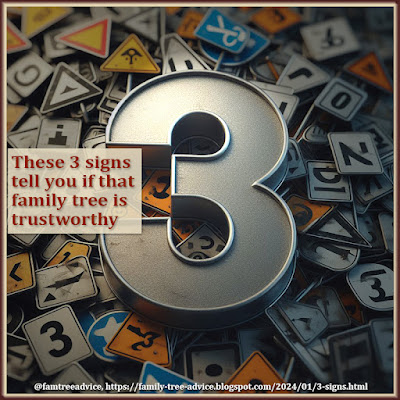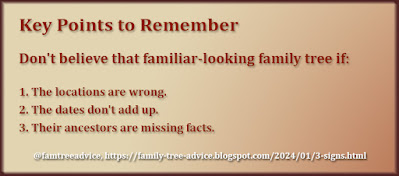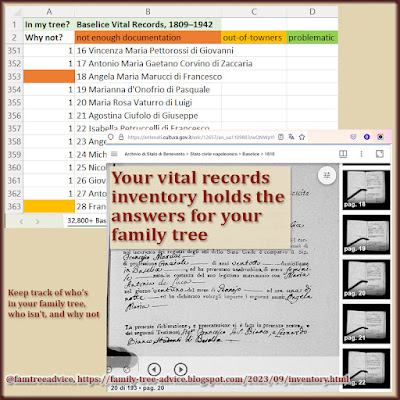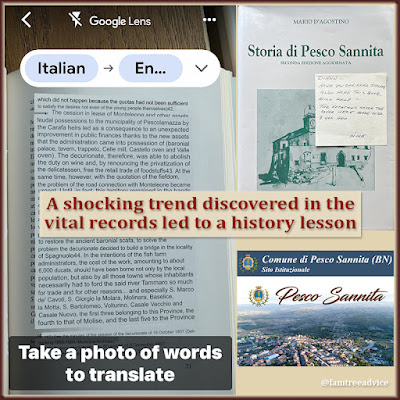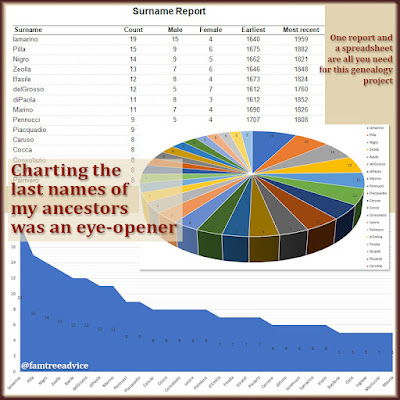You may have seen people sharing a different kind of family tree online. Instead of showing the names of their direct ancestors, each block shows a person's place of birth. I made a somewhat different version of this chart.
My family tree is so extensive, it includes nine of my 9th great grandparents. When I created my Elder Scroll, it was clear I had more ancestors from one town than any other. Having more Colle Sannita roots than any other justifies all the time I spend on this town.
But a visual is always nice, isn't it?
 |
| Get out your crayons! Create your Origins Chart and see clearly which places are the most important to your genealogy. |
To make my origins chart, I used the 10-generation fan chart I exported from MyHeritage last April. These are so beautiful and fun to look at. If your tree is on FamilySearch or Ancestry, you can see your fan chart there, too.
I used Photoshop for this project, but you can make an old-school version. Print your fan chart in black and white and get out different colored markers or crayons.
The MyHeritage fan chart using blocks of color to separate my ancestral lines. It uses a different color for each of my 8 great grandparents. There's also a version that shows all the names rather than color blocks.
I opened the color-block chart in Photoshop and kept the fan chart with all the names open on MyHeritage. (You can keep your family tree open for reference if you aren't using MyHeritage.)
Divide and Color
Starting at the center with myself, I saw that my maternal grandmother, my mother, and I were all born in New York City. So I outlined the 3 of us, filled the area in with one color (yellow), and wrote New York City on top of it.
If you're doing this on paper, outline and/or color in each group of people from one place. Make a separate key to show which place each color represents.
Next I chose the area representing my father. It was already colored baby blue, so I kept that color and labeled it Ohio. He's my only ancestor born there. His mother is my only ancestor born in New York State, outside the city, so she gets her own label, too.
Now comes the parts of my family tree with the deepest roots. The reason I kept my tree open on MyHeritage was so that I could click any person and see where they were born. My maternal grandfather and all his ancestors came from Baselice, Benevento, Italy. I outlined them, made them red, and labeled them with the town name.
All my great grandfather Sarracino's ancestors came from one town. His wife and her paternal ancestors came from the same town. So I outlined those blocks and made them orange. I labeled them Sant'Angelo a Cupolo, Benevento, Italy. Then I carved up my great grandmother Saviano's maternal ancestors. I colored in and labeled them: (1) Santa Paolina, Avellino, Italy, and (2) Apice, Benevento, Italy.
My paternal grandmother's section was simple. Her maternal side came from one town. I colored them green and labeled them Pesco Sannita, Benevento, Italy. Her paternal side was all Colle Sannita. So is most of my paternal grandfather's side. I carved out the ancestors not from Colle and colored them dark blue. I labeled them Circello, Benevento, Italy. Everyone else on my paternal side is from Colle Sannita. I colored them a lighter blue and labeled them Colle Sannita, Benevento, Italy.
 |
| These colorful fan charts from MyHeritage inspired me to turn my family tree into an Origins Chart. |
How to Use Your Origins Chart
As you look at your colorful origins chart, remember to keep the scale in mind. My chart has a big chunk of yellow from New York City, but that represents only 3 people. The big chunk of baby blue from Ohio is only one person—Dad. His family was only in Ohio for a short time, and he moved to New York City as a toddler. So despite the large block of color, Ohio represents a very small part of my genealogy research.
It's the earlier color blocks that drive my genealogy research. When you consider the scale, Colle Sannita is an enormous chunk of my family tree. The second largest is Baselice. I've spent years researching these towns' vital records. I created and published inventories of all the available vital records. I have fit almost everyone from these towns into my family tree.
But it's clear I can do a lot more work with the other towns. I've gathered the vital records for all my direct ancestors already. But with such deep roots, there's much more to discover.
- Sant'Angelo a Cupolo is problematic because they have no vital records before 1861. But I can try to connect more of the town's families.
- Pesco Sannita holds a lot of promise for me.
- Santa Paolina is my only ancestral town outside of the Benevento border. It's close by in the neighboring province of Avellino. I've found DNA cousins with roots in this town. I need to connect more of those families.
- Circello has an added bonus to drive my research. My aunt's husband had roots there and in Colle Sannita. That gives me lots of ways to connect to him and his children, my maternal 1st cousins.
- Apice, the little ghost town I've written about before, is my latest target. I've almost completed an inventory of its available vital records. My nearest ancestor from Apice, my 3rd great grandmother, was born in 1816. That's so early that I didn't expect to find a lot of relatives. I was wrong. Like all these small towns, every family intermarried. That creates a lot of connections I'm eager to pull into my family tree.
You can see how your origins chart can focus and drive your research. Of all the towns I've visited, it was Colle Sannita and Baselice that had the strongest pull on my heart. My origins chart actually bears that out.
Can you see which places in your origins chart make up the most of you? If you have lots of unknown places—areas you can't color in—that's where you should focus your work. What if you haven't done any research in a place that winds up being a very important part of your story?
I invite you to create and share your origins chart. Then use it to guide your genealogy research.


